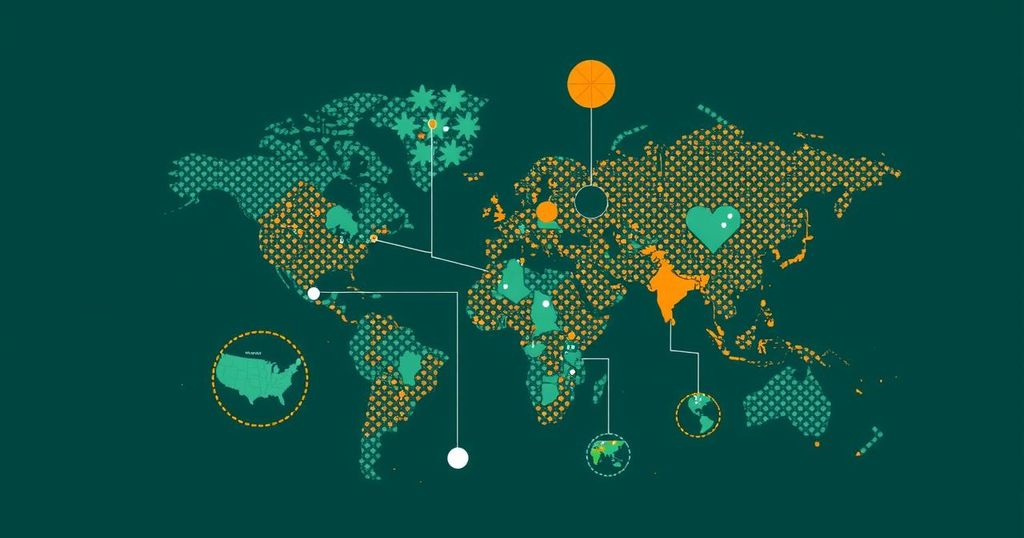At COP29, UNAIDS and UNDP warned that the climate crisis threatens to reverse progress against the AIDS epidemic. Their report highlights the risks of degraded health services, food and water insecurity, and rising HIV infections, particularly in countries that are both climate-vulnerable and heavily burdened by AIDS. With a tripartite funding crisis affecting these nations, urgent action is required to address the interlinked challenges of climate change and HIV.
At the COP29 Climate Conference in Baku, Azerbaijan, the Joint United Nations Programme on HIV/AIDS (UNAIDS) and the United Nations Development Programme (UNDP) cautioned that the ongoing climate crisis poses a severe risk to HIV services. Their report outlines that diminishing public health infrastructure, increased prevalence of diseases correlated with HIV, and escalating food and water scarcity due to climate changes may lead to a surge in new HIV infections and more AIDS-related deaths. The convergence of health emergencies, including the AIDS epidemic, alongside the climate crisis, requires urgent attention and coordinated action to avert further deteriorations in public health conditions, particularly in regions most affected by these challenges.
Winnie Byanyima, Executive Director of UNAIDS, emphasized the fragility of the progress made against AIDS, warning that extreme climate conditions could unravel such achievements. She stated, “The progress we have made tackling AIDS is fragile – and it could be unwound by runaway climate change.” UNAIDS highlighted that many of the countries most vulnerable to climate change also bear the highest rates of HIV infections. With an alarming statistic, it is revealed that each week, among 4,000 adolescent girls and young women aged 15 to 24 newly infected with HIV, 3,100 reside in Sub-Saharan Africa, a region increasingly jeopardized by severe environmental crises.
The funding needed to mitigate the impacts of both the HIV epidemic and the climate crisis is critically lacking. The Global Fund to Fight HIV, Tuberculosis, and Malaria is allocating 70% of its financing to the 50 nations most affected by climate change. However, these countries are grappling with a tripartite funding crisis, experiencing a significant US$ 9.5 billion gap in HIV resources, compounded by onerous sovereign debt. In numerous locations, healthcare spending is eclipsed by debt servicing, particularly in Western and Central Africa, where spending on debt exceeds healthcare expenditures by seven-fold.
The recent Cyclone Freddy drastically impacted Malawi, a country already contending with a cholera outbreak and still grappling with the aftereffects of the COVID-19 pandemic. This disaster displaced approximately 37,000 individuals living with HIV, showcasing how natural calamities intersect starkly with public health emergencies. At COP29, there were strong calls for governments to enhance leadership systems, address inequalities, and secure sustainable funding to effectively tackle the intertwined crises posed by climate change and the AIDS epidemic.
Marcos Neto, Director at UNDP, expressed hope for collaborations between communities and institutions affected by these crises, asserting that the AIDS response has illuminated pathways forward. He ushered a commitment to integrate health considerations into climate initiatives, asserting that it is essential for safeguarding progress in public health and fostering resilience against future adversities.
Furthermore, UNAIDS and UNDP will be facilitating a dialogue on the intersections of HIV and climate change at COP29 to galvanize support for joint solutions to these pressing global challenges. As we approach critical junctures in global health and environmental policy, the integration of these domains appears vital not only for averting a climate-induced AIDS crisis but also for reinforcing frameworks that prioritize community health and systemic sustainability.
The report by UNAIDS and UNDP accentuates an alarming connection between climate change and the AIDS epidemic, especially in regions with high HIV burdens. The relationship underscores the vulnerabilities faced by communities, particularly in Sub-Saharan Africa, where environmental challenges overlap with public health crises. With funding gaps and increasing debt burdens exacerbating these problems, the need for holistic solutions addressing both environmental changes and health outcomes has become paramount. This situation is compounded in many developing nations that simultaneously confront economic and climate pressures, necessitating urgent global cooperation and policy integration.
In summary, the intersection of the climate crisis and the HIV epidemic presents a critical challenge that requires immediate attention from global leaders. The report from UNAIDS and UNDP at COP29 highlights the fragility of the progress made against AIDS amidst worsening climate conditions, particularly in the most vulnerable nations. With a clear call to action, stakeholders are urged to address funding shortages and systemic inequalities to safeguard both public health and climate resilience for the future.
Original Source: reliefweb.int






